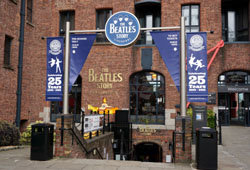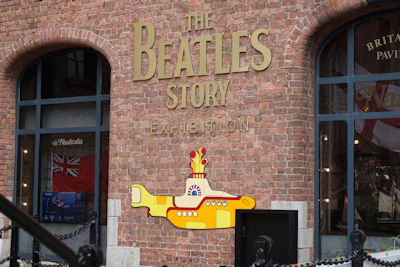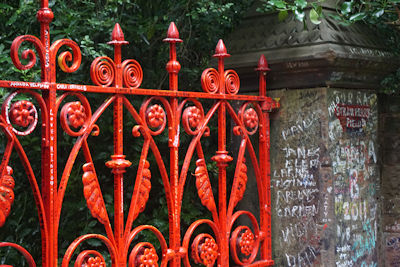
On February 19, 1963, the Beatles took the stage at the famed Cavern Club on Mathew Street in Liverpool. A telegram from manager Brian Epstein was read to the audience before the performance officially began, informing the group that their latest single, “Please, Please Me,” had risen to number one on the New Musical Express charts. Instead of cheers from the crowd, however, the news was met with silence. Apparently everyone in attendance realized that the Beatles no longer belonged to Liverpool, but all of England instead.
Although it would be another two-and-a-half years before the Beatles performed their last concert in their hometown, it was by then as “visitors” and not residents of the city, with over 5,000 people on hand to witness their final show. But while the Fab Four may have physically left Liverpool, the region continued to influence and inspire their music nonetheless, including such classics as “Penny Lane,” “Strawberry Fields Forever” and even the short snippet of “Maggie Mae” from the Let It Be album.
Just like it was impossible to separate the Beatles from their hometown roots of Liverpool, it is equally impossible to separate Liverpool from the Beatles, even after all the decades that have passed since their last performance there. Mathew Street is once again a hub of musical activity, while The Beatles Story museum sits along the banks of the Mersey River and both a Magical Mystery Bus Tour and Fab Four Taxi Tour escort fans around the childhood haunts of John Lennon, Paul McCartney, George Harrison, and Ringo Starr.
Although Beatles tourism is now a key component of the new Liverpool economy, that has not always been the case. During the 1960s and 70s, many residents and community leaders felt that the Beatles had abandoned the city after they conquered England, America and the rest of the world, and were thus not worthy of remembrance or accolades. The Cavern Club – often considered the place where the Beatles began – was even demolished in 1973, with the famed nightclub buried beneath the rubble from an underground railway system as a result.
It wasn’t until the death of John Lennon in December 1980 that any semblance of Beatles tourism began to take root in Liverpool, and that was under the guidance of local fans and entrepreneurs, not the city itself. In her 2007 book Decline, Renewal and the City in Popular Music Culture: Beyond the Beatles, for instance, University of Liverpool professor Sara Cohen credits local resident Ron Jones with launching the first “Discover Merseyside” campaign.
“Ron was a Beatles fan and he knew of other fans who were keen to visit Liverpool because of the Beatles, yet there was little information available to them on the city and its Beatles connections,” Cohen writes. “Ron therefore produced a Beatles souvenir pack entitled ‘The Beatles: From Liverpool to the World,’ and launched a Beatles Walk, Beatles package weekends and a bus tour with official Beatles guides.”
Cavern City Tours (CCT) followed shortly thereafter, building upon the initial efforts of Ron Jones. “One or two entrepreneurs expressed to us their resentment of what they regarded as CCT’s monopolization of Beatles tourism, but at the same time they gave the company credit for what it had achieved,” Sara Cohen further elaborates. “CCT was launched in 1983 and the company worked hard to rapidly expand and diversify its interests not only in tourism but in leisure and entertainment more generally. It established a daily ‘Magical Mystery Tour’ of local Beatles-related sites involving a brightly painted bus identical to the one used in the Beatles 1967 film Magical Mystery Tour. The tour passed by the former homes of the Beatles and involved scheduled stops at Penny Lane and Strawberry Field, places that had inspired Beatles songs and whose names featured in the song titles.”
Liverpool itself, meanwhile, was suffering through a period of economic decline in the 1980s stemming from the worldwide collapse of the manufacturing industry, including commercial shipping. In an effort to “reinvent” itself, the city turned the Albert Dock area into a cultural tourist attraction, with numerous museums, shops and restaurants along the bank of the Mersey River and within the decaying waterfront buildings themselves. It was at the Albert Dock that The Beatles Story museum launched in 1990, with replicas of key sites from the Beatles mythology inside – including The Mersey Beat newspaper offices, legendary Cavern Club and Abbey Road Studios – as well as tributes to Sgt. Pepper’s Lonely Hearts Club Band, Yellow Submarine, and the solo careers of each Beatle.
Tours of Beatles sites and The Beatles Story museum, however, are just two components of the present day Beatle experience in Liverpool, with Mathew Street and a replica Cavern Club being the third. The small alleyway is now closed to vehicular traffic and filled with statues and monuments to the Fab Four, and contains a Cavern Pub, Lennon’s Bar, and Rubber Soul Beatles Bar to go along with the resurrected Cavern Club itself. The Hard Day’s Night Hotel, meanwhile, sits on the corner of Mathew Street, and features statues of John Lennon, Paul McCartney, George Harrison, and Ringo Starr along the outer ledge above the establishment’s entrance.
While the British media initially lambasted the city of Liverpool for commercializing the connections between the region and its most famous natives, the proponents behind Beatles tourism recognized the fine-line between offering an authentic Beatles experience and a fabricated one nonetheless.
“Many of those we met expressed concerns about the commercial development of Beatles tourism in Liverpool,” Sara Cohen writes in Decline, Renewal and the City in Popular Music Culture: Beyond the Beatles. “Whilst that tourism was in various respects modelled on music tourism initiatives in North America, it was also frequently contrasted with Disney World or Graceland, both of which were used as familiar symbols of Americanization and the service economy, and of the commercial and inauthentic.”
In the end it was decided that “what people want is not to see Penny Lane as a big tourist attraction like Graceland, they want to see it as a working community which has not really changed very much.” Still, the connections between the Beatles and Liverpool are arguably greater than those between Elvis Presley and the aforementioned Graceland, and the corresponding tourist attractions in Liverpool ultimately reflect that fact.
“It is important to note that the Beatles connected themselves to Liverpool and were perhaps the first rock band to make their local origins a part of their commercial success,” Sara Cohen explains. “They wrote nostalgic songs about the city, for example, and Liverpool locations featured as a backdrop in some of the videos and films. They also emphasized their Liverpool origins and identity in media interviews, and their local dialect was a feature of their singing style as well as their speech.”
Being born and raised in Liverpool, however, had a deeper influence on John Lennon, Paul McCartney, George Harrison, and Ringo Starr that goes beyond mere nostalgia and childhood memories. Throughout much of its history, Liverpool was a port city, a transportation hub with an international reach. Immigrants flowed through the region, as well as sailors, merchants and tradesmen. This influx of diversity included a wide range of musical styles and traditions, leading to a unique mixture of sounds and instruments.
The Mersey Beat of the Beatles and other bands from Liverpool was directly influenced by this musical mishmash, with the Beatles taking the tradition even further by incorporating psychedelic and Indian sitars into their later recordings. Those songs may no longer have had a Mersey Beat running through their rhythms, but they were Liverpudlian in nature nonetheless.
Within the pages of Decline, Renewal and the City in Popular Music Culture: Beyond the Beatles, Sara Cohen remembers a coach tour of Liverpool that she took in 1996. Jackie the tour guide began the excursion by commenting on the number of people who have often claimed the title of the “Fifth Beatle,” with some of those assertions having merit while others did not.
“Towards the end of the tour, as the coach headed back,” Cohen writes, “Jackie began to dwell upon the Beatles relationship with Liverpool and the importance of Liverpool’s Beatles heritage for the city, before revealing, for the tour’s finale, that the real fifth Beatles ‘will of course always be the city Liverpool.’”
For anyone who has ever visited the region, truer words have never been spoken.
Anthony Letizia





